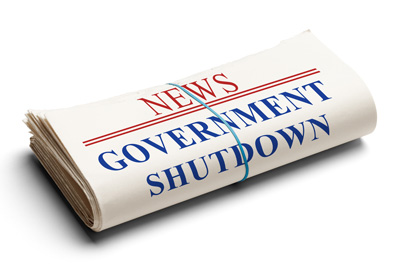Charting the Course
Investment Implications of Government Shutdowns and Budget Deficits
By Mitch Siegler, Senior Managing Director

Well, our nation’s capital is in the headlines again – and not for reasons that warm our hearts. Chaos abounds as we’re in the midst of another government shutdown. This, while we continue to wrestle with ballooning budget deficits. Investors are left wondering how these twin fiscal and political cyclones may ripple through the U.S. economy and about the implications for inflation, employment, interest rates and portfolio values.
Government shutdowns have been normalized as a way for our two political parties to play chicken in fighting for things important to their bases and preventing the other side from achieving success. Since 1976, we’ve seen 20 funding gaps and ten government shutdowns. (We all knew politics was rough and tumble, but this is the stuff of blood sports.) Shutdowns are the political equivalent of labor strikes, they’re great at shutting things down and shifting blame but generally not effective in generating sustainable outcomes.
Since D.C. politicians rarely ask us for advice, we focus on what we can control. As investors, we’re left pondering what shutdowns and deficits could mean for the Federal Reserve’s (Fed’s) future interest rate moves and, by extension, what the year ahead may bring in terms of apartment investment opportunities?
Uncertainty Abounds
It’s been challenging to hold a staff meeting, investor call or webinar or even draft an email without wrestling with economic uncertainty, which can be unsettling. Unfortunately, the grown-ups in Washington often make things worse, not better. On the bright side, disciplined and patient investors can find nuggets of opportunity, even in a sea of uncertainty. In that spirit, let’s unpack what’s happening in Congress, how it might impact Fed policy, and what that means for apartment owners and investors.
You Never Find Just One Cockroach…
 When you hear that the U.S. government has had 20 funding gaps and ten shutdowns since 1976, you won’t be shocked to hear that disciplined and parsimonious behavior aren’t hallmarks of our government – which has racked up $1.8 trillion in deficits in the current fiscal year – a level previously associated with times of war or financial crisis. Our nation now has outstanding debts approaching $38 trillion – about $108,000 for each American.
When you hear that the U.S. government has had 20 funding gaps and ten shutdowns since 1976, you won’t be shocked to hear that disciplined and parsimonious behavior aren’t hallmarks of our government – which has racked up $1.8 trillion in deficits in the current fiscal year – a level previously associated with times of war or financial crisis. Our nation now has outstanding debts approaching $38 trillion – about $108,000 for each American.
Times change but it’s pretty much like the movie Groundhog Day: national parks close, TSA and Air Traffic Control shut down, paychecks for service members and federal employees are delayed, and consumer confidence takes a hit.
Our deficit is greatly concerning. Interest on the national debt is the fastest-growing line item in the budget – expected to exceed defense spending within a few years. Interest rates, which have doubled in the past three years, increase the size of the deficits.
For policymakers, this creates a vicious cycle; the higher interest rates rise, the more expensive it is for the Treasury to finance its obligations. Of course, this also leads to higher deficits. And with higher deficits, there’s more pressure on the Fed to eventually bring rates down – if only to relieve the government’s own debt-service burden.
However, that doesn’t mean the Fed will cut quickly or meaningfully. The central bank’s dual mandate – stable prices and stable employment – still dominates, and the Fed has been scarred by previous inflation spikes, most recently the post-pandemic jump in prices in 2021–2023. While the President pounding on the Resolute Desk and calling on the Fed Chair to slash rates makes headlines, it probably doesn’t help.
Fed Chair Powell is Walking a Tightrope
The Fed faces a delicate balancing act. While inflation has cooled from its highs, it’s higher than many economists and policymakers would like and it has remained sticky in some areas – like services, housing (including rents) and salaries/wages. Meanwhile, there are numerous signs of slowing economic growth – tariffs have reduced global trade and exports, corporate profits are slowing as is hiring and artificial intelligence could lead to massive layoffs. Uncertainty damages consumer confidence. A prolonged government shutdown could be the straw that breaks the camel’s back, tipping the economy into recession.
All that said, the futures markets are betting on rate cuts. The CME FedWatch tool pegs the odds of 25-basis point rate cuts at 97% for October and 86% for December. (A basis point is 1/100 of a percent.) Despite jawboning from the President, the Fed generally moves slowly and cautiously but we think we’re finally on the cusp of more rate cuts.
Implications for Multifamily Investment
So, what does all this mean for multifamily real estate investors? Investment returns benefit from debt leverage and we are only recently seeing positive leverage return (where the interest rate is below the capitalization (“cap”) rate, providing a boost to the investment). With time, lower interest rates can also translate into lower cap rates, which is also bullish for property values. So, we’d be happy to see lower interest rates after several years of elevated rates.
As interest rates rose in 2022-2023, borrowing costs surged, multifamily transaction volumes plummeted, and property values fell by 15–25% (depending on property type and market) from their cyclical peak in 2022. Fed rate cuts would relieve some of the pressure on cap rates, restore liquidity to the market and give transaction volume a shot in the arm.
Many pundits have been saying that we’re a quarter or two away from lower rates – for quite a few quarters. Eventually, they’ll be right. We believe the next quarter could be an inflection point for interest rates and more downward pressure next year is likely. Lower rates would be a tailwind for multifamily acquisitions, which is one of many reasons we believe now is an opportune time to scoop up well-located properties at attractive prices before values rebound.
Want a Reason to Invest Now in Multifamily? Here are 600 Billion of ‘Em.
An estimated $600 billion in multifamily loans come due during the next 24 months. Many were underwritten at the peak of the market in 2021-2022 at around 3% interest rates; the current refinance environments is near 6%. But it’s worse than that since many of these owners took on short-term (three-year) loans at floating rates. That dog don’t hunt (aka, the math doesn’t work, and these folks may have no path to refinance – many will be forced to sell at 75 cents on the dollar of what they paid.)
Danger presents opportunity for the well-heeled buyer. At Pathfinder, we like to buy our straw hats in the winter – and winter is coming for these peak-of-the-market buyers who have short-term, adjustable-rate loans they can’t refinance.
Sure, Fed rate cuts will help a few of these borrowers but the math won’t fundamentally change for most, even if the Fed slashes rates by 100 basis points over the next 12 months. Getting a good deal on straw hats by buying at the right time is our thesis for Pathfinder Multifamily Opportunity Fund IX. We’re not trying to time the Fed. Instead, we’re focused on a meat and potatoes strategy: acquiring well-located properties at attractive cost bases in solid, growing markets, using conservative leverage. When rates eventually decline, that’s gravy.
Falling apartment deliveries in the next several years and a nationwide shortage of several million housing units means rent growth is quite likely in the next few years. Lower interest rates could lead to cap rate compression, which would be a bonus. We believe that 2025-2026 will prove to be a fine time to acquire well-located apartment properties and the next few years will be a great time to own them.
Bringing it Back to D.C.
 We hate gridlock and dysfunction. We need air traffic controllers and the TSA for our commercial airlines to function, and our brave soldiers, sailors and airmen and our federal employees should be receiving their paychecks. Government shutdowns further erode the public trust. Massive deficits add to the chaos. If we could snap our fingers, Democrats and Republicans would work together constructively to find compromise and wouldn’t resort to shutting down the government. And like prudent households, our federal government wouldn’t spend more than it takes in, and we wouldn’t have a budget so far out of balance. But that’s not our current reality.
We hate gridlock and dysfunction. We need air traffic controllers and the TSA for our commercial airlines to function, and our brave soldiers, sailors and airmen and our federal employees should be receiving their paychecks. Government shutdowns further erode the public trust. Massive deficits add to the chaos. If we could snap our fingers, Democrats and Republicans would work together constructively to find compromise and wouldn’t resort to shutting down the government. And like prudent households, our federal government wouldn’t spend more than it takes in, and we wouldn’t have a budget so far out of balance. But that’s not our current reality.
While headlines about shutdowns and deficits create fear and uncertainty, disciplined investors should maintain perspective. The U.S. economy remains resilient. People need a place to live, we have a several-million-unit housing shortage and about half of Americans rent. While none of these things will change anytime soon, that’s the investment opportunity ahead. And speaking of change, let’s hope the government reopens soon and the economy doesn’t suffer serious or long-lasting damage.
Mitch Siegler is Senior Managing Director of Pathfinder Partners. Prior to co-founding Pathfinder in 2006, Mitch founded and served as CEO of several companies and was a partner with an investment banking and venture capital firm. He can be reached at msiegler@pathfinderfunds.com.
Share this Article
IN THIS ISSUE
PATHFINDER MULTIFAMILY OPPORTUNITY FUND IX, L.P. AND UPCOMING WEBINARS
CHARTING THE COURSE
Investment Implications of Government Shutdowns and Budget Deficits
FINDING YOUR PATH
The Fed, The Fed, The Fed
ANNOUNCING THE CLOSING OF THE FLETCHER
GUEST FEATURE
Insights from the Corner Office: A Conversation with Mitch Siegler, Pathfinder’s Co-Founder
ZEITGEIST
News Highlights
TRAILBLAZING
Creating Peace of Mind
NOTABLES AND QUOTABLES
Foresight
